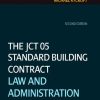Control of welding distortion in thin plate fabrication Design support exploiting computational simulation 1st Edition by Tom Gray ISBN 9781845695354 1782421203
$50.00 Original price was: $50.00.$35.00Current price is: $35.00.
Control of welding distortion in thin plate fabrication Design support exploiting computational simulation 1st Edition by Tom Gray – Ebook PDF Instant Download/Delivery: 9781845695354, 1782421203
Full download Control of welding distortion in thin plate fabrication Design support exploiting computational simulation 1st Edition after payment

Product details:
ISBN 10: 1782421203
ISBN 13: 9781845695354
Author: Tom Gray
Control of Welding Distortion in Thin Plate Fabrication by Tom Gray explores methods to predict, analyze, and reduce welding-induced distortion in thin metal plates. By integrating computational simulation tools into the design process, the book provides engineers and fabricators with practical strategies to enhance dimensional accuracy, reduce rework, and improve manufacturing efficiency. It is especially valuable for those working in shipbuilding, aerospace, and precision fabrication industries.
Table of contents:
1 Introduction: development of computational welding mechanics approach to welding distortion
1.1 Background: control of welding distortion in fabrication practice
1.2 Aims: integrated design approach utilising computational welding mechanics (CWM)
1.3 Structure of the book
1.4 Conclusion
1.5 References
2 Fabrication of stiffened thin-plate structures and the problem of welding distortion
2.1 Introduction
2.2 Welding distortion of stiffened-plate and other fabricated structures
2.3 Outline of a typical fabrication process
2.4 Raw materials and primary process factors
2.5 Management issues relevant to thin-plate distortion
2.6 Rectification of thin-plate distortion
2.7 Conclusion
2.8 References
3 Tools to deal with welding distortion: predictive modelling and research on in-process techniques
3.1 Introduction
3.2 Artificial neural networks (ANNS)
3.3 Computational simulation
3.4 Current research on reduction of distortion
3.5 Conclusion
3.6 References
4 Understanding welding distortion: thermal fields and thermo-mechanical effects
4.1 Introduction
4.2 Thermal fields: dependence on welding parameters and material properties
4.3 Thermo-mechanical effects
4.4 Thermo-mechanical treatment based on longitudinal-transverse uncoupling
4.5 Plane strain strip: longitudinal deformations and forces
4.6 Transverse welding deformations
4.7 Residual stress
4.8 Buckling
4.9 Conclusion
4.10 References
5 Computational simulation of welding distortion: an overview
5.1 Introduction
5.2 Multi-physics
5.3 Thermal property non-linearity
5.4 Phase change and non-linear thermal dilatation
5.5 Mechanical property idealisation
5.6 Thermal computation outline
5.7 Range of thermo-mechanical approaches available
5.8 Reduced solutions and their advantages
5.9 Conclusion
5.10 References
6 Experimental investigation of models of welding distortion: methods, results and comparisons
6.1 Introduction
6.2 Importance of experimental observations
6.3 Welding process application in test work
6.4 Thermocouple arrays
6.5 Thermography
6.6 Deformation measurement
6.7 Completion and smoothing of measured deformation profiles
6.8 Characterising out-of-plane deformation
6.9 Conclusion
6.10
References
7 Modelling thermal processes in welding
7.1 Introduction
7.2 Convection and radiation
7.3 Heat input modelling
7.4 Simulation of weld deposition
7.5 Thermal property non-linearity
7.6 Three-dimensional transient thermal computation
7.7 Transient finite-element model based on two-dimensional cross-section
7.8 Thermal computation in stiffener fillet weld geometries
7.9 Welding efficiency
7.10 Thermal cutting
7.11 Conclusion
7.12 References
8 Computationally efficient methods for modelling welding processes
8.1 Introduction
8.2 Computationally efficient methods based on algorithms
8.3 Hybrid stepwise solution methods
8.4 Conclusion
8.5 References
9 Finite-element thermo-mechanical techniques for welding distortion prediction
9.1 Introduction
9.2 Formulation of thermo-mechanical finite-element model
9.3 Case study: influence of tacking procedures on butt-weld distortion
9.4 Case study: fillet-welded stiffened plate
9.5
Conclusion
9.6 References
10 Simulating welding distortion in butt welding of thin plates
10.1 Introduction
10.2 Plate support and out-of-flatness influences
10.3 Effects of tacking
10.4 Clamping effects
10.5 Residual stress in butt welds
10.6 Multiple butt welds
10.7 Conclusion
10.8 References
11 Simulating welding distortion in fillet welding of stiffened plate structures
11.1 Introduction
11.2 Plates with double-sided continuous fillet-welded single stiffeners: thermal aspects
11.3 Plates with double-sided continuous fillet-welded single stiffeners: computationally efficient thermo-mechanical treatment
11.4 Multiply-stiffened plates: case study on welding sequence
11.5 Conclusion
11.6 References
12 Exploiting welding distortion models: examples of design and manufacturing strategies to optimise fabrication
12.1 Introduction
12.2 Optimising multi-stiffener configuration
12.3 Optimising the design in terms of weld position
12.4 Limiting heat input to avoid buckling
12.5 Simulation of transient thermal tensioning: fabrication-related distortion reduction study
12.6 Simulated use of low-transformation-temperature filler material to reduce distortion
12.7 Simulated use of weld-trailing cryogenic cooling process to reduce distortion
12.8 Conclusion
12.9 References
People also search for:
how do you control distortion in welding
welding distortion control methods
what is distortion in welding
what are the causes of distortion in welding
controlling weld distortion
Tags: Tom Gray, Control of welding, thin plate, Design support, computational simulation


